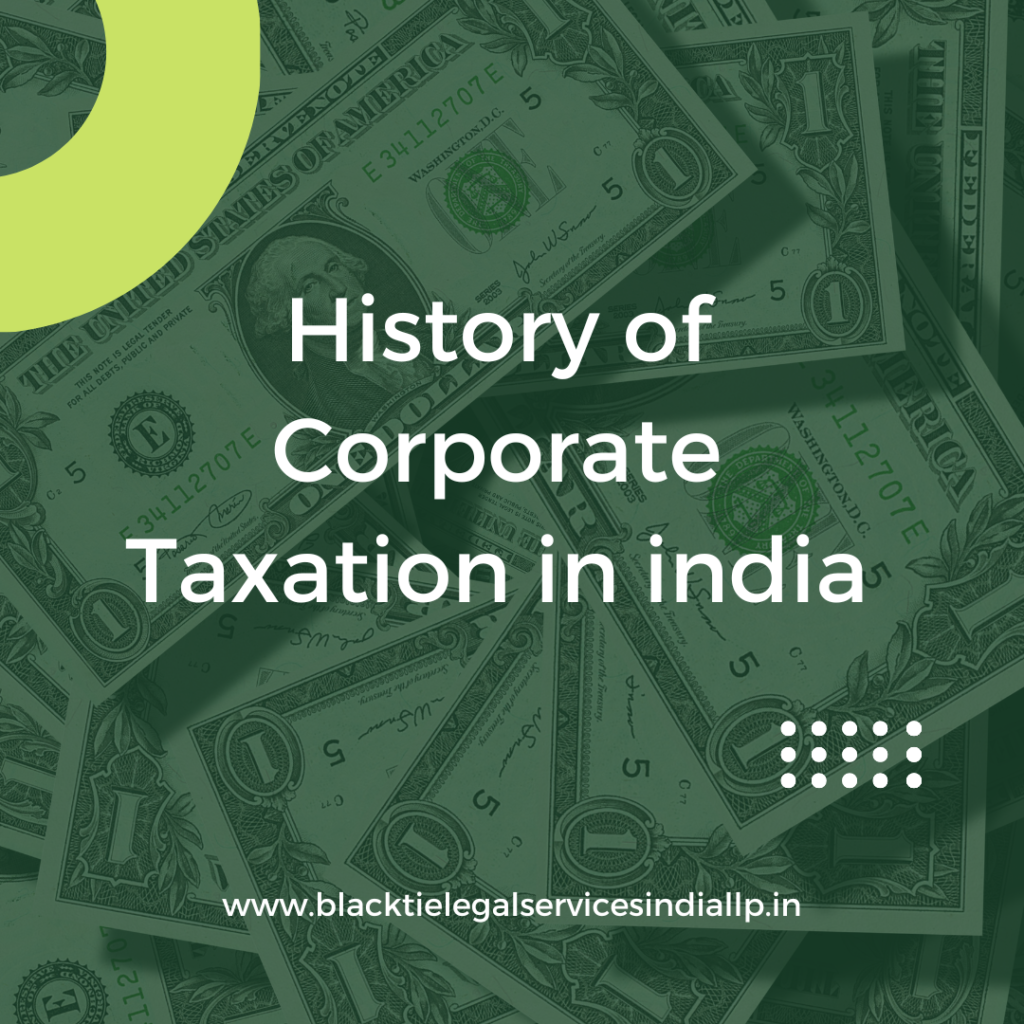You are very well aware that corporate taxation is a very important aspect of the overall economic structure of India. With the help of which there is a significant and positive impact on business operations, government revenue and the overall economy.
Our country India has seen many big changes in corporate taxation in the last few years, which reflects our country’s developing economic policies and goals in a very good manner.
Hence, it is essential that every citizen of our country who does work related to corporations or is excited to know about it should have detailed information about corporate taxation in India.
Therefore in this blog post we have provided a comprehensive guide for all of you regarding corporate taxation in India.
Our objective behind this blog post is that you will get all the information about it which you will not be able to get from anywhere else.
History of Corporate Taxation in India

The history of corporate tax has been explained in detail with the help of the paragraphs given below so that you can get a proper and accurate information about it.
The roots of the system of corporate taxation in India were laid down in the British colonial era and that too when the Income Tax Act of 1860 was introduced.
After independence, it was developed with the enactment of the Corporate Taxation in india Act of 1961, which later became the cornerstone of tax law and still remains so.
Over the years, corporate tax rates have been finely adjusted in response to economic conditions, financial needs, and global trends.
Current Corporate Tax Structure

If we talk about 2024 now, India’s corporate tax structure is characterized by different tax rates for both domestic and foreign companies as well as a variety of exemptions and incentives aimed at promoting investment and growth.
Tax Rates
We have explained the tax rates of both companies in detail with the help of the paragraphs given below:
Domestic Companies
- Base Rate: The standard corporate tax rate for domestic companies is 22% without exemptions/incentives. However, companies availing certain deductions and incentives are taxed at 30%.
- Within India, for assessment year (AY) 2024-25, the base rate of domestic companies depends only on the tax regime chosen by the companies. Hence, we have shown all the applicable tax rates in the concise table below:
| Type of Company | Tax Rate | Additional Details |
|---|---|---|
| Domestic Companies (Standard Regime) | 30% | Applies to companies not opting for the concessional regime. |
| Domestic Companies (Concessional Regime under Section 115BAA) | 22% | Companies must not claim any deductions or incentives. |
| Domestic Companies (Concessional Regime under Section 115BAB) | 15% | Available to manufacturing companies meeting specific conditions. |
| Domestic Companies (New Regime under Section 115BA) | 25% | For new manufacturing companies with certain conditions. |
| Domestic Companies (Start-up Regime under Section 80-IAC) | 15% | For eligible start-ups, provided they meet specific criteria. |
Foreign Companies
- Base Rate: According to Nirmala Sitharaman Murthy’s budget of July 2024, now all foreign companies will be taxed at 40% on the income earned in India. Lack of access to domestic incentives and higher perceived risk have contributed to this tax rate.
Surcharges and Cess
In addition to the base tax rates, companies are also subject to surcharges and health and education cess.
- Surcharge: Depending on your earnings, India’s government imposes a progressive surcharge that ranges from 7% to 12% for all domestic companies and 2% to 5% for all foreign companies.
- Health and Education Cess: An additional 4% tax is levied on the total tax (including surcharge) for all companies, whether domestic or foreign.
Recent Form

Our country, India, has made many reforms in its overall corporate tax system in recent years, the main objective of which is to enhance the business environment, promote financial development, and attract all foreign investments. Therefore, we have explained the recent forms in detail in the paragraphs given below:
- Tax Rate Reduction (2019): In September of the year 2019, the government of our country that is the Republic of India announced an unbelievably massive reduction in all the corporate tax rates. The objective of this particular reform was to stimulate the economy, promote investment and raise India’s tax systems to the international level.
- Incentives for New Manufacturing: The introduction of 15% tax rate for new manufacturing companies was a strategic step to establish India as a manufacturing hub. This not only develops the manufacturing industry but also results in employment and growth of the economy.
- Faceless Assessments: The faceless assessments and appeals in the process of filing taxes help in making the process easier for businesses. Demonstration of efficiency enables business entities to put more effort and means into the implementation of tax policies, thus lowering the significance of bureaucratic constraints and transparency in tax systems.
- Vivad se Vishwas Scheme: The Vivad se Vishwas Scheme is an appropriate solution for the business organizations as it deals with the doctrines of long standing. Thus, finally, these disputes must be resolved because companies would be able to concentrate on their activities without constant interference and doubtful legal proceedings.
Implications for Businesses

The corporate tax reforms in our country, India, have had a significant impact on all the businesses operating in the country. Which we have written in detail below:
- Increased Competitiveness: Corporate taxation of India has been reduced making the country much more competitive when compared to other countries. Decrease in taxes serves to enhance the anticipated returns for the firms; which they can use to expand their operations hence create more jobs.
- Encouragement of Manufacturing: Hence, in this context, new manufacturing units get the benefit of a more favourable tax regime, which encourages companies to set up manufacturing units in India. Moreover, it increases the production capacity of manufacturing industries and provides employment opportunities and economic growth.
- Simplified Compliance: Faceless Assessment and Appeal in SONE streamlines businesses’ tax compliance and makes the process easier. The need for formalities is eliminated, and there is availability for ease of dealing with taxes, leading to lower costs and less time spent on taxes.
Challenges and Criticisms

Despite all the positive impacts of now, our country, India, still has to face a lot of tax policies, challenges and criticisms, which we have explained in detail below for you to understand:
- Complexity: The tax structure within India is still chaotic, and has many loopholes including exclusions, deductions and differentiated rates depending on the type of company and sector. This remains a challenge especially for new establishments and foreigners looking to invest in India due to the competitive and complex tax system in the country.
- High Effective Tax Rate: There has been a modest reduction in taxes, but tax rates are still very high for many companies due to surcharges and cess. This may reduce the impact of rate cuts and may also slow down the rate of taxation on companies.
- Tax Disputes: The concept of Vivaad se Vishwas scheme is designed to put an end to pending disputes, but the high number of cases highlights some fundamental problems in the administration and collection of taxes. Although significant progress has been made in the field of tax law, some areas are still problematic such as the fairness and timeliness of tax dispute resolution.
- Sector-Specific Incentives: Rather than prioritizing specific sectors through something as ‘basic’ as tax rates, this can cause hardship and could easily be seen as discrimination against industries such as manufacturing. In fact, there may be some benefits to tackling the problem and bringing in a more coordinated taxation policy in the future.
Future Outlook

The future of corporate taxation in India is being shaped by economic developments, government policies, and global trends over time. To understand this aspect, we have written detailing all its future outlooks:
- Digital Economy: Taxes will also need to evolve in the future in an attempt to address issues around taxing digital content and multinational companies, particularly in technology. Moving towards a fairer taxation structure could also be considered in the form of the introduction of an equalisation levy, but more comprehensive measures may be required.
- Global Tax Reforms: The integrated approach, in which base erosion and profit shifting (BEPS) deals with the taxation policies of different countries, will also impact Indian tax law. India will have to integrate its taxation system with international trends and norms so that its own revenues are not adversely affected.
- Sustainability and Green Taxation: Taking into account the numerous transformations occurring in the world and having regard to global goals, including sustainable development, and the climate change, the principles of green taxes and benefits connected with a concerns for environmental friendliness prevalence may appear an issue in India.
- Ease of Doing Businesses: Further efforts also need to be focused on simplifying tax procedures, reducing litigation and creating a better environment for doing business. Measures that enhance the business environment as a factor of production will also help boost investment and, hence, economic growth.
In Conclusion

Corporate taxation in India has developed so quickly because it has come a long way from its colonial roots to cater to a dynamic and growing economy.
Talking about recent reforms, corporate taxation in India has made significant progress in increasing competitiveness, simplifying compliance, and making all investments much more accessible.
However, challenges still remain and it is very important to continuously make all efforts to address all these issues and create a more robust and equitable tax system.
In this blog post, we have presented before you the corporate taxation in India and all its aspects in detail and accurately.
So, we hope that you will not face any kind of complication while reading this blog. And you must have got a lot of information from this blog post.
FAQs
Q1. What is Minimum Alternate Tax (MAT)?
A1. Minimum Alternate Tax (MAT) is a tax provision in India requiring companies to pay a minimum amount of tax based on their book profits, regardless of tax exemptions claimed.
Q2. What is the corporate tax rate in India 25%?
A2. India’s corporate tax rate isn’t fixed. It ranges from 15% to 30%, depending on factors like company type, turnover, and chosen tax regime. Surcharges and cess also apply.
Q3. How is tax calculated?
A3. Tax calculation involves determining your total income, subtracting applicable deductions and exemptions, applying the corresponding tax rate based on the remaining taxable income, and then potentially adding surcharges and cess.
Q4. Is TCS an indirect tax?
A4. Yes, TCS (Tax Collected at Source) is an indirect tax. It’s similar to TDS (Tax Deducted at Source) but is collected by the seller from the buyer on certain transactions and then deposited with the government.
Q5. How much income is tax free?
A5. The exact tax-free income limit varies based on age and tax regime chosen. Under the old regime, individuals below 60 years can earn up to ₹2.5 lakhs tax-free, while those between 60 and 80 years can earn up to ₹3 lakhs tax-free.


Add a Comment